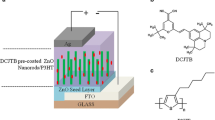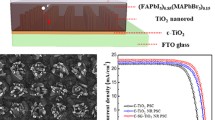Abstract
We fabricate inverted organic/inorganic hybrid solar cells based on vertically oriented ZnO nanorods and polymer MEH-PPV. The morphology of ZnO nanorods and ZnO nanorods/MEH-PPV hybrid structure is depicted by using scanning electron microscopy (SEM), X-ray diffraction (XRD), and atomic force microscope (AFM), respectively. It is observed that ZnO nanorods array grows primarily aligned along the perpendicular direction of the ITO substrate. The MEH-PPV molecule does not enter the interspace between ZnO nanorods completely according to SEM picture. It results in the small and bad contact area between ZnO nanorods and MEH-PPV. To improve the photovoltaic performance, we also fabricate another kind of photovoltaic (PV) device modified by N719 dye, and exploit the effect of N719. After the modification of ZnO nanorods by N719, not only J sc increases from 0.257 mA/cm2 to 0.42 mA/cm2, but also V oc enhances from 0.37 V to 0.42 V. Insert LiF buffer layer between MEH-PPV and anode, J sc of 1.05 mA/cm2 is obtained, and it is 2.5 times that the device without LiF.
Similar content being viewed by others
References
Tang C W. Two-layer organic photovoltaic cell. Appl Phys Lett, 1986, 48: 183–185
Oregan B, Gratzel M. A low-cost, high-efficiency solar cell based on dye-sensitized colloidal TiO2 films. Nature, 1991, 353: 737–740
Bach U, Lupo D, Comte P, et al. Solid-state dye-sensitized mesoporous TiO2 solar cells with high photon-to-electron conversion efficiencies. Nature, 1998, 395: 583–585
Boucle J, Ravirajan P, Nelson J. Hybrid polymer-metal oxide thin films for photovoltaic applications. J Mater Chem, 2007, 17: 3141–3153
Peumans P, Forrest S R. Very-high-efficiency double-heterostructure copper phthalocyanine/C60 photovoltaic cells. Appl Phys Lett, 2001, 79: 126–128
Li G, Shrotriya V, Huang J, et al. High-efficiency solution processable polymer photovoltaic cells by self-organization of polymer blends. Nat Mater, 2005, 4: 864–868
Kim J Y, Kim S H, Lee H H, et al. New architecture for high-efficiency polymer photovoltaic cells using solution-based titanium oxide as an optical spacer. Adv Mater, 2006, 18: 572–576
Gur I, Fromer N A, Chen C P, et al. Hybrid solar cells with prescribed nanoscale morphologies based on hyperbranched semiconductor nanocrystals. Nano Let, 2007, 7: 409–414
Sun B Q, Greenham N C. Improved efficiency of photovoltaics based on CdSe nanorods and poly(3-hexylthiophene) nanofibers. Phys Chem Chem Phys, 2006, 8: 3557–3560
Thitima R, Patcharee C, Takash S, et al. Efficient electron transfers in ZnO nanorod arrays with N719 dye for hybrid solar cells. Solid-State Electron, 2009, 53: 176–180
White M S, Olson D C, Shaheen S E, et al. Inverted bulk-heterojunction organic photovoltaic device using a solution-derived ZnO underlayer. Appl Phys Lett, 2006, 89: 143517
Hsu C W, Wang L, Su W F. Effect of chemical structure of interface modifier of TiO2 on photovoltaic properties of poly(3-hexylthiophene)/TiO2 layered solar cells. J Colloid Interf Sci, 2009, 329: 182–187
Lin Y Y, Lee Y Y, Chang L W, et al. The influence of interface modifier on the performance of nanostructured ZnO/polymer hybrid solar cells. Appl Phys Lett, 2009, 94: 063308
Goh C, Scully S R, McGehee M D. Effects of molecular interface modification in hybrid organic-inorganic photovoltaic cells. J Appl Phys, 2007, 101: 114503
Author information
Authors and Affiliations
Corresponding author
Rights and permissions
About this article
Cite this article
Yan, Y., Zhao, S., Xu, Z. et al. The effect of modified layers on the performance of inverted ZnO nanorods/MEH-PPV solar cells. Sci. China Phys. Mech. Astron. 54, 453–458 (2011). https://doi.org/10.1007/s11433-010-4230-8
Received:
Accepted:
Published:
Issue Date:
DOI: https://doi.org/10.1007/s11433-010-4230-8




